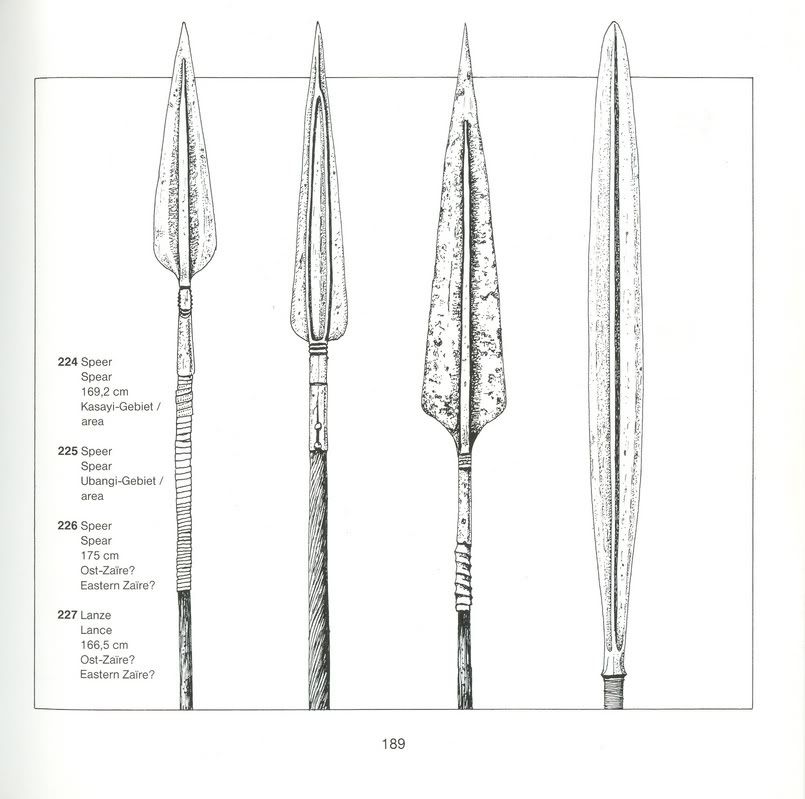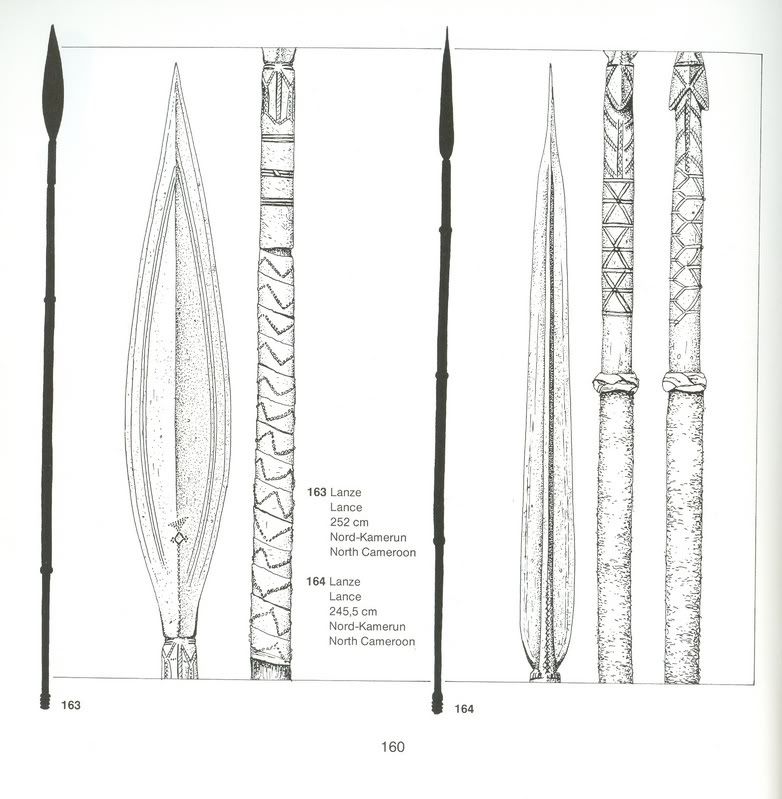
 |
|
|
#1 |
|
(deceased)
Join Date: Dec 2004
Location: Portugal
Posts: 9,694
|
Hello, i am needing some guidance.
I have just bought these, in a street fair.They look some old and reasonably cared of, though. The ones with the large sockets have no traces from their hafts, but the fixing nails are still there, and looking original. The one with the more fragile socket has the haft stump left inside. The material is wood and the fixing is done with three tiny studs. Maybe a modern arrangement, i don't know enough to judge. Any coments on their provenance, age and classification would be much wellcome. fernando |
|
|

|
|
|
#2 |
|
Member
Join Date: Jun 2006
Location: On the banks of Cut Bank Creek, Montana
Posts: 189
|
From the imfoprmation I have in my massive two volume library on the Zulu culture those are not Zulu.
Zulu spears are tang and not socket and have no decoration. Nice looking blades how ever. |
|
|

|
|
|
#3 |
|
Member
Join Date: Dec 2004
Location: Sint-Amandsberg (near Ghent, Belgium)
Posts: 830
|
I've been checking my books and found this in 'Waffen aus Zentral-Afrika' (Museum für Völkerkunde, Frankfurt am Main - 1985) :
A similar blade as spear blade #1 can be found on page 189, fig. 226. According to this book it is attribuated to a tribe in Eastern Congo (Nsakara ?).  The other two blades #2 and #3 could be from Northern Cameroon. If you look at page 160, fig. 163, you can see the similarity in decoration on the spear blade in the book and on your two blades. The book gives no further details.  I hope this helps ? 
|
|
|

|
|
|
#4 |
|
(deceased)
Join Date: Dec 2004
Location: Portugal
Posts: 9,694
|
Splendid track, Freddy
So much obliged for that.. Could you guess the age of these pieces ? 19th century? Last edited by fernando; 23rd July 2006 at 04:28 PM. |
|
|

|
|
|
#5 | |
|
(deceased)
Join Date: Dec 2004
Location: Portugal
Posts: 9,694
|
Quote:
I thaught those steel collars on the Iklwas were actual blade sockets. One never ceases to learn. Last edited by fernando; 23rd July 2006 at 04:44 PM. |
|
|
|

|
|
|
#6 |
|
Member
Join Date: Dec 2004
Location: Sint-Amandsberg (near Ghent, Belgium)
Posts: 830
|
Difficult to tell the age of these blades. The Cameroon blade in the Museum book was collected between 1900 and 1908.
Yours could be of the same age. But that's just my guess. 
|
|
|

|
|
|
#7 |
|
(deceased)
Join Date: Dec 2004
Location: Portugal
Posts: 9,694
|
Dank u wel
|
|
|

|
|
|
#8 |
|
(deceased)
Join Date: Dec 2004
Location: Portugal
Posts: 9,694
|
Hi again, Double D
The only Iklwa i have has an iron collar, instead of the often seen binding. For a moment i made up in my mind that it was the blade socket ... silly me. BTW, can you pronounce "Umhlanga" like the locals do ? Beautyfull place. No sharks around, anymore ? fernando |
|
|

|
|
|
#9 |
|
Member
Join Date: Jun 2006
Location: On the banks of Cut Bank Creek, Montana
Posts: 189
|
You mean umshlanga!
Here is the a picture of an isiJula showing the cow tail binding method binding a Zulu spear.  I have this iKlwa with a woven rattan binding.  I have another iKlwa that is very old that came from a thatched roof that has just leather wrapping.  This last one is an awesome blade and I would not feel uncomfortable saying this may, may be a Shaka era blade. Freddy, would you know if that museum has a similar book on Southern Africa? |
|
|

|
|
|
#10 |
|
(deceased)
Join Date: Dec 2004
Location: Portugal
Posts: 9,694
|
My only Iklwa.
I am sure this blade fixing system is also to consider. |
|
|

|
|
|
#11 |
|
Member
Join Date: Jun 2006
Location: On the banks of Cut Bank Creek, Montana
Posts: 189
|
Interesting. My guess is that if you examine the band very closely you will find it is a separate pieces and not part of the blade. Didn't you say that already? Yep scrolled down aand there it was. Can you see if there is any kind of binding under the band?
I have a seen a lot of the binding of copper, copper and steel wire, copper and aluminum wire and colored plastic coated wire. Krige reports that when the Zulu troops returned from battle, "The warriors threw away their loin cloths worn during the war and cleaned up their spears, fitting them with new handles." So it would only seem normal for new types of bindings to show up. |
|
|

|
 |
|
|